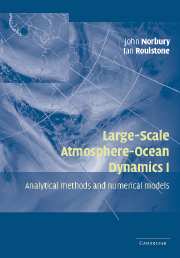Book contents
- Frontmatter
- Contents
- Contributors
- Preface
- Introduction and Scientific Background
- 1 A view of the equations of meteorological dynamics and various approximations
- 2 Extended-geostrophic Euler–Poincaré models for mesoscale oceanographic flow
- 3 Fast singular oscillating limits of stably-stratified 3D Euler and Navier–Stokes equations and ageostrophic wave fronts
- 4 New mathematical developments in atmosphere and ocean dynamics, and their application to computer simulations
- 5 Rearrangements of functions with applications to meteorology and ideal fluid flow
- 6 Statistical methods in atmospheric dynamics: probability metrics and discrepancy measures as a means of defining balance
6 - Statistical methods in atmospheric dynamics: probability metrics and discrepancy measures as a means of defining balance
Published online by Cambridge University Press: 04 February 2010
- Frontmatter
- Contents
- Contributors
- Preface
- Introduction and Scientific Background
- 1 A view of the equations of meteorological dynamics and various approximations
- 2 Extended-geostrophic Euler–Poincaré models for mesoscale oceanographic flow
- 3 Fast singular oscillating limits of stably-stratified 3D Euler and Navier–Stokes equations and ageostrophic wave fronts
- 4 New mathematical developments in atmosphere and ocean dynamics, and their application to computer simulations
- 5 Rearrangements of functions with applications to meteorology and ideal fluid flow
- 6 Statistical methods in atmospheric dynamics: probability metrics and discrepancy measures as a means of defining balance
Summary
Introduction
The aim of this chapter is to introduce a probabilistic approach to defining balance for geophysical flows. Geophysical flows are split into fast and slow components where the slow component describes some ‘average’ or ‘macroscopic’ large scale evolution, whereas the fast component describes the more rapid fluctuations of particle positions on a ‘microscopic’ fine or very local scale. We will treat the fast variables as random variables and, in the spirit of statistical physics, we will identify fluid microstates as measure-preserving maps, and fluid macrostates as probability distributions on the set of microstates. A balanced flow will then be characterised by a particular macrostate (i.e. probability distribution), which is, in a sense to be defined later, the most likely for the observed macroscopic properties of the fluid. We will characterise semigeostrophic flow as the most likely evolution of minimum energy states consistent with the large-scale constraints of the system.
Like many other physical systems, the atmosphere has both fast and slow dynamics. The slow dynamics describe the macroscopic or averaged evolution of the air ‘parcels’ (say approximately 10 km by 10 km in the horizontal, by 100m in the vertical, or more), whereas the fast dynamics describes the microscopic or fine scale rapid movement of air ‘particles’ (of sizes about 10–100 m3) that are 108–109 × smaller. To the synoptic large scale modeller these fast microscale motions are mostly irrelevant and a nuisance. First, these (often unstable) motions do not usually provide information relevant to the largescale model; secondly they are often associated with unwanted phenomena, such as gravity waves; and thirdly they often lead to instabilities that plague numerical calculations.
- Type
- Chapter
- Information
- Large-Scale Atmosphere-Ocean DynamicsAnalytical Methods and Numerical Models, pp. 342 - 370Publisher: Cambridge University PressPrint publication year: 2002



